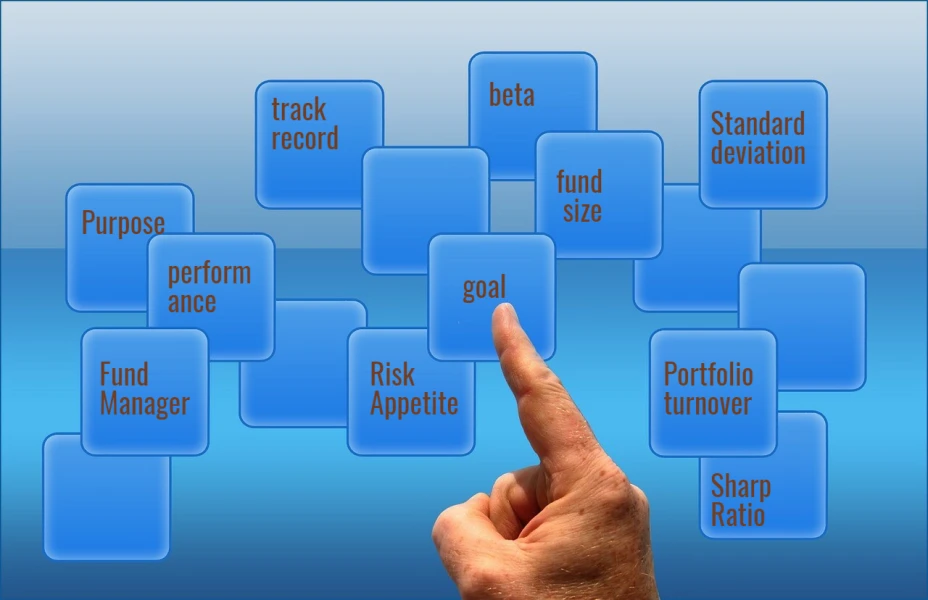When it comes to investing in Mutual Funds, choosing the right scheme is crucial for achieving your financial goals while managing risks effectively. This guide will walk you through the key considerations to make an informed and strategic decision.
Investing in Mutual Funds demands careful analysis and selection. A poorly chosen fund can result in the erosion of your hard-earned savings. To ensure your investment aligns with your objectives, risk tolerance, and time horizon, it’s essential to follow a systematic approach.
Several investors depend on prevailing market trends or turn to advice from family and friends.
This approach might not be the most fitting solution. Instead, seek out a fund that aligns with your requirements.
Various Mutual Fund Schemes could be more suitable for distinct financial objectives and investment timelines.
Although investors can narrow down suitable Mutual Fund categories for their requirements, it’s also crucial to choose a specific fund within the chosen category.
Before you take any decision, you should ask yourself questions:
What is the purpose of investing in Mutual Fund?
Clearly outlining your objectives simplifies the process of investing and monitoring your progress.
Having well-defined goals makes investing and tracking progress simpler.
It could involve desires like realizing a dream vacation, funding your child’s education, planning for retirement, or acquiring your long-desired home.
What is the duration of your investment?
The duration of your investment refers to the length of time you intend to hold a particular asset or investment.
This time frame can vary widely based on your financial goals, risk tolerance, and the specific investment vehicle you’re considering.
Short-term investments are typically held for a shorter duration, often less than a year, while long-term investments are held for several years or even decades.
Your investment duration plays a critical role in determining the level of risk you’re comfortable with, as well as the potential returns you can expect to achieve.
It’s important to align your investment horizon with your financial objectives to make informed decisions that suit your individual circumstances.
Criteria for selecting Mutual Funds
When it comes to choosing the most suitable Mutual Fund, numerous factors warrant consideration. These encompass evaluating the fund’s historical performance, expense ratio, fund size, the expertise of the fund manager, expected returns, risk tolerance, investment horizon, financial acumen, and various other benchmarks.
Before embarking on your investment journey, dedicating time to research is essential. This aids in making well-informed decisions and gaining a clearer grasp of the key aspects that hold significance in the realm of mutual funds.
Let’s look at some important aspects to consider when choosing an investment fund.
Setting clear Goals:
The initial stride towards selecting the optimal mutual fund involves defining your objectives. These objectives act as compass points, guiding you towards the fund that best aligns with your aspirations. While crafting your selection, take into account factors such as your desired investment duration, expected returns, and additional relevant considerations.
Yet, it’s crucial to note that an absence of clear objectives doesn’t necessarily warrant truncating your journey. Investment goals can also form part of your investment target. To provide clarity, here are several illustrative instances:
- Retirement Planning
- Planning for a Vacation
- Funding Child’s Higher Education
- Home Purchase
- Pursuit of Other Long-Term Objectives
The choice of the appropriate mutual fund category, be it Equity Fund, Debt Fund, Balance Advantage Fund, or Hybrid Fund, hinges on your ultimate goal.
Consistency in Performance
Check how a plan compares to other schemes based on the stated benchmarks before deciding on one. In addition, as well as the returns that are generated by benchmark indexes must also be reported. One can compare the fund’s performance to benchmark returns to assess the alpha produced by the fund. This is the amount of excess returns from the fund over benchmark returns.
Investors should be aware that historical returns are not an assurance of future returns.
It could help investors feel confident with the fund’s investment strategy based on the investment plan the fund employs.
Understanding Time Horizons:
The duration of your investment matters. Long-term goals, like retirement planning, involve higher risk tolerance, while short-term goals demand a more cautious approach. Factor in your investment horizon when selecting a mutual fund.
Choosing the Right Fund Category:
Different Mutual Fund categories serve diverse financial goals. Equity Funds, Debt Funds, Balance Advantage Funds, and Hybrid Funds cater to specific objectives. Matching the fund category with your end goal enhances the likelihood of success.
Assessing Risk Tolerance:
This pertains to the investor’s capacity to withstand risk, coupled with their comprehension of the inherent risks associated with each mutual fund.
As an illustration, Equity-oriented Mutual Funds carry greater risk, leading to potential fluctuations in the portfolio’s value.
Nevertheless, the returns from Equity Mutual Funds often surpass those of other funds, appealing to investors embracing a “high risk, high return” approach.
On the contrary, debt funds, hybrid funds, and balanced funds present reduced risk and enhanced security. While their returns may be comparatively lower than those of stock mutual funds, they stand as an excellent option for prudent and novice investors.
Tax Efficiency:
Every investor, especially newcomers, should consider tax implications. The taxation of returns from equity mutual funds is contingent upon the duration of holding and the applicable tax rate.
When factoring in taxes, mutual funds generally demonstrate efficiency in generating after-tax returns.
Analyzing Fund House Track Record:
When you buy Mutual Fund, you put your trust in the fund house to manage your money. The decisions taken by fund houses and fund managers might have an impact on the performance of your investment as well as the achievement of your financial goals. Before selecting the best scheme, it is necessary to confirm the name of the fund house, as well as its history of existence and track records across several schemes.
Consistency in Performance:
Compare fund performance against benchmarks and previous periods. Analyze the alpha, indicating excess returns over benchmark. Note that historical returns don’t guarantee future performance but can indicate an effective investment strategy.
Considering Scheme Size (AUM):
Fund size plays a role in performance. While larger funds may see performance decline, larger fund families can enhance performance. Balance the trade-offs when evaluating fund size.
Fund Manager’s Impact:
Active Funds’ performance hinges on the Fund Manager’s decisions. Evaluate the current manager’s performance and, if new, consider their track record in managing other schemes.
Assessing Risk-Return Balance:
Analyze how funds perform relative to the risk they carry. Opt for schemes that generate comparable returns with lower risk, determined by factors like portfolio concentration and standard deviation.
Matching Risk Profile:
Harmonize your risk tolerance with the fund’s risk profile. If volatility is a concern, adjust your shortlist accordingly. Ensure the selected scheme aligns with your comfort level.
Quantitative Ratios:
Amidst the multitude of fund options, quantitative ratios assist in identifying quality schemes. Consider standard deviation for volatility, Sharpe ratio for risk-adjusted returns, beta for risk assessment, and turnover ratio for portfolio management efficiency.
Conclusion:
Selecting the right Mutual Fund involves a blend of thorough analysis and alignment with personal goals and risk tolerance. Past performance is a piece of the puzzle, not the whole picture. Evaluate each factor, create a tailored investment strategy, and diversify to optimize your chances of success.
Remember, mutual fund performance hinges on an array of influences. Make an informed decision by integrating all elements, securing your financial future.
Consider Scheme Size (AUM)
One of the important aspect is fund size.
“As fund size grows, performance suffers. As small-cap funds grow, their performance suffers proportionally more than that of large-cap funds. As fund family size grows, however, fund performance actually improves.”
Fund performance as of the current Fund Manager
Fund Managers principally make investment decisions when it comes to active funds. It is logical for investors to evaluate the fund’s performance under the current manager.
If the fund manager has just been appointed to manage the Scheme, it is possible to want to look at the alpha produced by other schemes that were previously managed.
Assessing Risk-Return Balance
How the funds have produced results comparable to the risk taken in the portfolio.
If similar returns were produced through two mutual fund schemes, the one with less risk should be chosen.
The risk profile for the Scheme could be determined by looking at the level of concentration in the portfolio, the sharp ratio, standard deviation and others.
Risk Appetite of the Investor
It is also essential for investors to match their risk tolerance with the appropriate funds.
For instance, the investor could have narrowed down a small-cap fund but may not like the short-term volatility.
In this scenario, the shortlisted scheme should be removed from consideration and alternatively, mutual fund options can be considered that match the investor’s risk profile.
With these parameters in consideration, investors need to make an informed choice on how they will follow their financial objectives.
Quantitative Aspects- Ratios
With 1,500 plus schemes within the Mutual Fund (MF) industry, and new ones being added every day, there are many choices for investors to pick from.
Here are four ratios to assist you in separating good ones.
Standard Deviation:
Standard deviation measures the extent to which the fund’s volatility has been.
The standard deviation is the spread of returns from its return on average.
Find schemes that have a lower standard deviation if you’re cautious. However, if the fund’s manager isn’t conservative enough, this can cause over-diversification or lower performance.
The biggest drawback of the standard deviation lies in its failure to differentiate between bad and good volatility since it considers positive and negative returns based on the average return.
Sharp Ratio:
A Sharpe proportion of any fund helps you understand how the fund’s performance has been about the risk it has taken it.
The Sharpe ratio measures the additional returns that a fund has earned over a risk-free return from investments, such as a short-dated Government Treasury Bill for the investment’s risk.
Beta:
If you want to know how risky your fund is compared to its benchmark index, take a look at your Beta ratio. If the fund’s beta ratio is greater than 1, it is riskier than the benchmark index.
If it’s only 1, your investment is as at risk as to the benchmark index. All passively managed funds, including exchange-traded and index funds, have a beta of 1.
If the beta falls lower than one, the fund is more stable than its benchmark index.
Portfolio Turnover Ratio:
The Fund Manager purchases and sells securities regularly when the fund is well-managed.
The frequency with which your fund manager rotates the portfolio is assessed through a formula known as the turnover ratio in your portfolio. Typically, it’s determined over one year.
A low turnover ratio indicates an investment manager usually uses a ‘buy and keep strategy.
A higher turnover means more expenses (brokerage taxes, brokerage, etc.) at the scheme level for mutual funds, ultimately paid by investors, thereby decreasing the return.
However, a high turnover rate isn’t necessarily alarming. It could be due to the tendency to take profits frequently from investment.
Conclusion
The most beneficial Mutual Fund Plans are not identical for all investors. It may vary based on the various aspects.
The best way to pick the most suitable Mutual Fund Plan for your investment is to consider your objectives, risk profile, and time frame.
Do not choose Mutual Fund solely on their performance in the past.
Take your risk profile and goals into consideration, and then make an inventory of mutual fund options suitable to your needs.
The performance of mutual funds is contingent on many factors, and another influences each element in one way or another.



